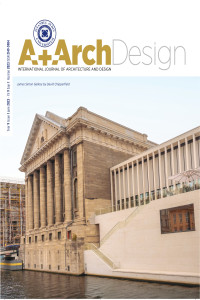Abstract
References
- REFERENCES
- REFERENCE1 Emerson, 2009. Daylight harvesting in retail stores.
- REFERENCE2 Tzempelikos A., July, 2005. A Methodology for integrated daylighting and thermal analysis of buildings. A Thesis in the Department of Building, Civil and Environmental Engineering.
- REFERENCE3 Hennesy, T., 1996. “Open to change: Daylighting creates wide-open feeling and a maze of options.”Store Equipment and Design.
- REFERENCE4 Boubekri, M., 2008. Daylighting, Architecture and Health: Building Design Strategies
- REFERENCE5 Yener A., 2007. Binalarda günışığından yararlanma yöntemleri: Çağdaş Teknikler. VIII. Ulusal Tesisat Mühendisliği Kongresi.
- REFERENCE6 Sui, G., Liu, J., Leng, J., Yu, F., 2023. “Daylighting performance assessment of traditional skywell dwellings: A case study in Fujian, China”, Journal of Building Engineering, Volume 68.
- REFERENCE7 Robins C. & Hunter K., 1984. “A method for determining interreflected in clear climates”, SERI/TR-254-1845, Golden, Colorado.
- REFERENCE8 Phillips, D., 2004. Daylighting - Natural Light in Architecture, Architectural Press, Oxford.
- REFERENCE9 Emerson, 2009. Daylight harvesting in retail stores.
- REFERENCE10 IESNA, 2011. The lighting hand book. New York: IESNA.
- REFERENCE11 TS EN 12464-1, 2021. Işık ve Aydınlatma-Çalışma Alanlarının Aydınlatılması Standardı.
- REFERENCE12 TS EN 17037+A1, 2022. Binalarda Günışığı Standardı.
- REFERENCE13 Anon, 1994. Alışveriş Kompleksi: Galleria, İş-Alışveriş Merkezleri, Yapıdan seçmeler no:3, Yapı-Endüstri Merkezi Yayınları, İstanbul.
- REFERENCE14 http://www.flyinn.com.tr/kurumsal, Erişim Tarihi 06.07.2022
- REFERENCE15 Balcıoğlu, S., 2007. Profilo Alışveriş Merkezi Halkla İlişkiler Sorumlusu, Kişisel Görüşme.
Abstract
Designs that can make maximum use of daylight in shopping areas, provide visual comfort conditions for users, increase the work performance and provide economic benefits in addition to healthy and relaxing spaces. In this context, as a method, illuminance level measurements were made at the determined points in the circulation areas of selected shopping centres; Galleria, Flyinn, Profilo and Cevahir AVM, and in line with the results obtained, the shopping center with the lowest illuminance level is chosed and a system design is proposed. In order to examine the relationship between the illuminance levels under different lighting conditions, the natural lighting simulation model of the shopping mall was composed and measurements were carried out for the characteristic dates of the year which are 21 March, 21 June, 21 September and 21 December. The aim of the study is to provide maximum natural lighting efficiency in the space; to provide economic benefits, to increase the workforce in the shopping mall, and thus to increase the satisfaction rate of the users, to ensure the sustainability of the use of the shopping mall. As a result of the study, evaluations were made by comparing the current measurements and a proposal of natural lighting system performance.
Keywords
References
- REFERENCES
- REFERENCE1 Emerson, 2009. Daylight harvesting in retail stores.
- REFERENCE2 Tzempelikos A., July, 2005. A Methodology for integrated daylighting and thermal analysis of buildings. A Thesis in the Department of Building, Civil and Environmental Engineering.
- REFERENCE3 Hennesy, T., 1996. “Open to change: Daylighting creates wide-open feeling and a maze of options.”Store Equipment and Design.
- REFERENCE4 Boubekri, M., 2008. Daylighting, Architecture and Health: Building Design Strategies
- REFERENCE5 Yener A., 2007. Binalarda günışığından yararlanma yöntemleri: Çağdaş Teknikler. VIII. Ulusal Tesisat Mühendisliği Kongresi.
- REFERENCE6 Sui, G., Liu, J., Leng, J., Yu, F., 2023. “Daylighting performance assessment of traditional skywell dwellings: A case study in Fujian, China”, Journal of Building Engineering, Volume 68.
- REFERENCE7 Robins C. & Hunter K., 1984. “A method for determining interreflected in clear climates”, SERI/TR-254-1845, Golden, Colorado.
- REFERENCE8 Phillips, D., 2004. Daylighting - Natural Light in Architecture, Architectural Press, Oxford.
- REFERENCE9 Emerson, 2009. Daylight harvesting in retail stores.
- REFERENCE10 IESNA, 2011. The lighting hand book. New York: IESNA.
- REFERENCE11 TS EN 12464-1, 2021. Işık ve Aydınlatma-Çalışma Alanlarının Aydınlatılması Standardı.
- REFERENCE12 TS EN 17037+A1, 2022. Binalarda Günışığı Standardı.
- REFERENCE13 Anon, 1994. Alışveriş Kompleksi: Galleria, İş-Alışveriş Merkezleri, Yapıdan seçmeler no:3, Yapı-Endüstri Merkezi Yayınları, İstanbul.
- REFERENCE14 http://www.flyinn.com.tr/kurumsal, Erişim Tarihi 06.07.2022
- REFERENCE15 Balcıoğlu, S., 2007. Profilo Alışveriş Merkezi Halkla İlişkiler Sorumlusu, Kişisel Görüşme.
Details
| Primary Language | English |
|---|---|
| Subjects | Architecture (Other) |
| Journal Section | Research Article |
| Authors | |
| Early Pub Date | June 30, 2023 |
| Publication Date | June 30, 2023 |
| Published in Issue | Year 2023 Volume: 9 Issue: 1 |
All site content, except where otherwise noted, is licensed under a Creative Common Attribution Licence. (CC-BY-NC 4.0)



